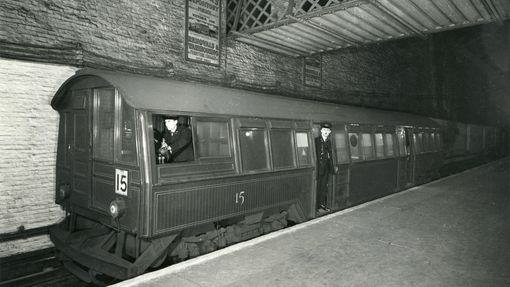
The District line
Key facts
Length: 64km
Stations: 60
Opened: 1868
Introduction
As the second oldest Underground line, the District has a complicated history. Once the most sprawling of railways, with links and deals with many others, its services were simplified to some extent after the formation of London Transport in 1933. But even today its operations are complex, with 60 stations and four branch lines off the main route, crossing 13 London boroughs and six fare zones. More than half of its stations connect to at least one other line.
Why is it called the District line?
The line was established as the Metropolitan District Railway, but quickly became known as the District due to the oldest Underground railway having already taken the name Metropolitan. It became the District line after the unification of London Transport in 1933.
History
Parliament was inundated with proposals for new lines following the opening of the first underground railway, the Metropolitan Railway, in 1863. Rather than scrutinise them individually, a committee was set up to prioritise the next steps in underground railway development. Considering the ‘Met’ route from Paddington to the City via King’s Cross, they concluded that further underground routes should link to it to form a circle to connect with the mainline railways at Victoria and Liverpool Street.
The directors of the Metropolitan formed the Metropolitan District Railway to do the job. The first section of the District, as it became known, opened between South Kensington and Westminster late in 1868. The two companies initially worked together, sharing the Met’s steam trains, as the District extended east to Embankment, Temple and Blackfriars. But by 1870 the company was deep in debt, and financial pressures led to a split with the Metropolitan.
Did you know?
The District line is the only line that uses bridges to cross the River Thames
The District started running its own trains in July 1871. Costs dictated that the line stalled at Mansion House, a mile short of their goal at Tower Hill. In the following years, the District extended west to Hammersmith, Richmond, Ealing and Hounslow, and south to Putney and Wimbledon.
The last part of the Circle was only completed in 1884 after an intervention by the government, but it opened up east London to both the Met and the District over the tracks of the East London Railway (ELR - now part of the Overground network). The District also partnered with the London, Tilbury & Southend Railway (LTSR) to build new stations on the ELR route, connecting Whitechapel with the LTSR station at Bow, and extending District services to Upminster.
Despite continuing differences, the Met and the District cooperated over electrification plans for the Circle. However, their initial ideas were rejected when a powerful American, Charles Tyson Yerkes, took over the ailing District in 1901 and imposed a US-style system. The District’s first electric services ran from Ealing to South Harrow in 1903 and reaching East Ham in 1905. Trains were powered by a huge new power station at Lots Road, Chelsea, which also powered three new Tubes that Yerkes had raised money for.
Did you know?
The District line has more stations than any other line, with 60
On 1 July 1933, all the capital’s bus, tram and Underground railway operations were brought together in a single organisation, the London Passenger Transport Board, soon to be known simply as London Transport. As a result, the District Railway became the ‘District line’. In the same year, the Uxbridge and South Harrow branches transferred to the Piccadilly line. Off-peak District line services on the Hounslow branch were withdrawn in 1935 and beyond Kensington (Olympia) in 1940.
Parts of the former LTSR line to Upminster were shared with steam locomotive hauled goods and passenger services until 1961, when the District took over, exclusively separating mainline and Underground services at Barking. Today’s District line serves 60 stations. It operates daily services between Upminster, Ealing Broadway, Richmond and Wimbledon. Wimbledon branch trains also operate to Edgware Road, and services to and from Kensington (Olympia) operate at weekends and during special events.
Did you know?
The fictional station Walford East, in the BBC soap opera EastEnders, is a District line station, taking the place of Bromley-by-Bow on the map



















